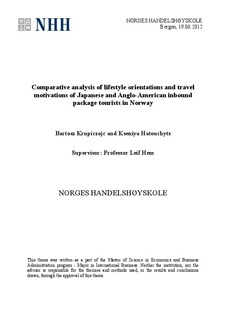| dc.description.abstract | The purpose of this thesis is to compare lifestyle orientations and travel motivations between
different nationality groups of inbound package tourists in Norway. Specifically, the present
study delineates differences in lifestyle orientations and travel motivations between Anglo-
American and Japanese tourists, who participated in the package tour Norway in a Nutshell.
Additionally, this study examines the relationships between lifestyle orientations and travel
motivations.
Overall, ‘family’ and ‘travel’ are the most important lifestyle orientation items for Anglo-
American and Japanese travellers, respectively. Furthermore, the analysis reveals statistically
significant differences between the two nationality groups with respect to four out of ten
lifestyle orientation items: ‘change/diversion’, ‘environmental awareness’, ‘family’, and
‘culture’. These findings are partly attributed to generational differences among the
respondents.
Using factor analysis, this thesis identifies five underlying travel motivation factors:
‘relaxation’, ‘physical’, ‘prestige/status’, ‘socialization’, and ‘novelty/knowledge’.
‘Novelty/knowledge’ and ‘socialization’ are the most important travel motivation factors for
all respondents (Anglo-American and Japanese tourists). Further, Anglo-American travellers
rank ‘novelty/knowledge’ as the most important travel motivation factor, whereas Japanese
rank ‘relaxation’ as the most important travel motivation factor. Furthermore, the
comparative analysis identifies statistically significant differences between the two
nationality groups with respect to all five factors of travel motivation.
Pearson product moment correlation analysis reveals twenty-four significant and positive
relationships between lifestyle orientations and travel motivations. Out of these relationships,
the following variables exhibit the strongest associations of medium size effect: i.) ‘physical’
and ‘environmental awareness’, ‘physical’ and ‘sports’, ‘physical’ and ‘health’; ii.)
‘novelty/knowledge’ and ‘environmental awareness’, ‘novelty/knowledge’ and ‘culture‘; and
iii.) ‘socialization’ and ‘family’.
Finally, this thesis provides theoretical and managerial implications for destination marketing
and management decision-makers to promote Norway more effectively as a tourist
destination abroad. | no_NO |
